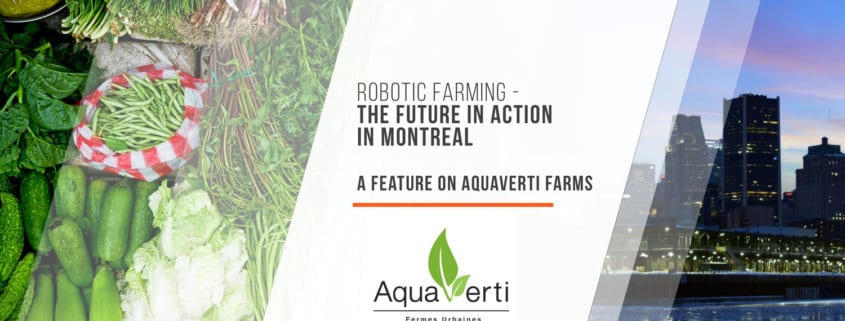Robotic Farming – The Future in Action in Montreal | A Feature on AquaVerti Farms
The evidence is as clear as the increasingly extreme weather conditions all over the world: we need to get serious about changing the way we do things if we’re going leave behind a livable planet.
It’s a scary truth, but there’s also a lot to be optimistic about because there are so many initiatives working to do just that.
One such initiative is a unique company in Ville St Laurent that’s blending technology from the automotive industry with Dutch agricultural practices to significantly reduce the carbon footprint of lettuce – a crop that typically requires a lot of land, water and pesticides to produce, and experiences a great deal of waste simply due to the delicacy of lettuce leaves and how easily they can be damaged in harvesting, packaging and transporting.
Aquaverti Farms has developed a lettuce growing method that produces 0 greenhouse gases, uses 0 pesticides, and requires 95% less water than traditional farming methods.
Housed in what is essentially a large factory, Aquaverti makes use of the vertical space with hydroponic ponds! How do the farmers get up there to tend to their crops? They don’t! The robots do. This is where automotive technology comes into play. Robotic machines set the ponds into place, monitor conditions and even harvest the crops. Aquaverti uses custom-designed LED lights and nutrients are fed directly into the pools growing the lettuce. It’s an incredibly efficiently process with just 35 days from seed to harvest.
The picture in your mind right now (and in reality) is probably a far cry from that picturesque vision we have of rows of crops growing from the earth, bathed in the natural sunlight. It’s reasonable to wonder if crops grown in a factory can really be as nutritious as those grown traditionally. The answer is, even more so.
Canada is the world’s largest importer of lettuce in the world (way to go on eating your leafy greens, folks!). That’s no surprise though, since our climate makes it a difficult crop to grow locally, and impossible to grow outdoors year round. If we want it, we have to import it. Unfortunately, from the moment most produce is harvested, it begins to gradually lose nutritional value. If it takes several days after harvesting for lettuce to reach your plate, it simply isn’t as nutrient-rich as it was straight from the farm. By producing locally, lettuce can reach your plate literally hours after harvesting, ensuring a fresher, crisper, more nutritious salad.
Aquaverti has set of goal of producing up to 2000 heads of lettuce each day, year round. They are currently focused on growing curly lettuce as it is so easily damaged in transport. Growing it locally mean less transportation, which means less waste. As a bonus, curly lettuce is delicious and makes for beautifully instagrammable salads. Looks pretty good on a bacon double cheeseburger too.
Can other vegetables be grown this way? Some, but not most. The conditions lettuce needs to grow well makes it uniquely suited for this type of farming, so while we likely won’t be seeing carrots or potatoes grown on hydroponic structures, it’s initiatives like Aquaverti that drive the innovation, creativity and passion we need to take our planet in a new, sustainable direction.
Want to know more about Aquaverti Farms? Check out their website or follow them on Facebook.










Trackbacks & Pingbacks
[…] Robotic Farming – The Future in Action in Montreal […]
Comments are closed.